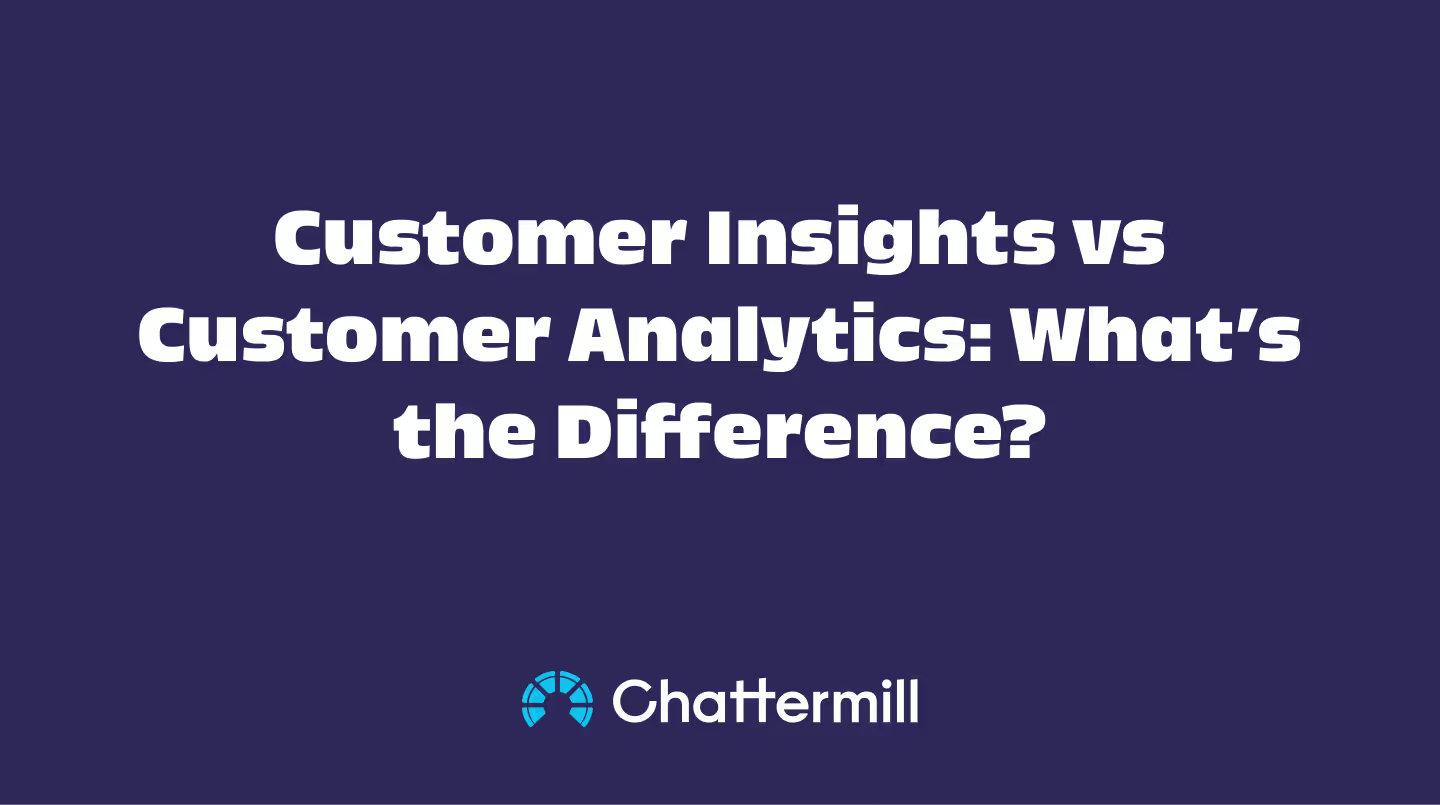Many teams use customer insights and customer analytics interchangeably, but they serve different purposes. Understanding the distinction helps teams select the right tools and strategies to improve decision-making.
In this guide, we explore how customer analytics helps you understand what is happening, while customer insights explain why it's happening. If you're researching tools like Chattermill, knowing the difference is critical.
What Is Customer Analytics?
Customer analytics involves collecting and analyzing behavioral data such as clickstreams, purchase history, retention trends, and app usage patterns. These tools help identify what users are doing and how they interact with your product or service.
Use cases include:
- Analyzing feature adoption or drop-off rates to identify usability or onboarding issues
- Tracking churn trends across user cohorts to determine risk factors
- Segmenting audiences by value, behavior, or lifecycle stage for targeted campaigns
- Forecasting revenue, LTV, or engagement trajectories based on historical trends
The primary benefit of customer analytics is clarity.
It gives businesses a quantitative view of how customers behave, what paths they take, where they get stuck, and which actions correlate with outcomes like conversion or churn.
This allows teams to:
- Optimize onboarding flows by pinpointing drop-off points
- Improve customer retention by identifying risky behaviors early
- Personalize experiences with dynamic content or messaging based on engagement
- Allocate resources more effectively to high-impact segments
- Measure performance of experiments or feature releases across cohorts
Organizations rely on tools like Google Analytics, Mixpanel, Heap, and SAS for these insights.
According to SAS, companies using customer analytics effectively are more likely to see increases in ROI, customer retention, and marketing efficiency. Similarly, Userpilot emphasizes how behavioral data fuels growth and product-led decision-making.
However, while analytics excels at showing what is happening, it often lacks the context to explain why it's happening. For example, analytics can show a spike in churn, but it can't tell you if customers are leaving due to product confusion, unmet expectations, or dissatisfaction. That’s where customer insights step in, to fill the gap between data and decisions.
If you're evaluating analytics tools, it’s worth reviewing Chattermill’s article on The Top Customer Feedback Tools
What Are Customer Insights?
Customer insights are deeper interpretations of data that explain the motivations, expectations, and sentiment behind user behavior. They often come from qualitative sources, like open-ended survey responses, support tickets, interviews, and reviews, and are especially valuable for CX, VoC, and product teams.
For example, analytics may show a spike in churn, but only insights reveal the underlying frustration with onboarding or a recent feature update. According to AmplifAI, insights help teams drive action, not just track metrics.
Developing strong customer insights involves:
- Aggregating data from surveys, chat logs, support channels, and behavior
- Using tools like sentiment analysis to identify themes, tone, and patterns
- Interpreting those findings into business decisions that improve CX and retention
Chattermill offers a platform purpose-built for this process. Their Ultimate Guide to Sentiment Analysis explains how insights evolve from raw feedback into action at scale.
Why the Difference Between Analytics and Insights Matters
Understanding the distinction clarifies which tools your team needs and how to structure your data workflows.
If your goal is to track engagement, usage trends, or churn risk, then customer analytics tools like Mixpanel or Google Analytics are a good fit. For deeper explanations of pain points, motivations, or satisfaction drivers, insight platforms like Chattermill are more appropriate.
Instead of a comparison chart, here’s how to evaluate your needs:
- If you want to know what users do: web analytics, funnel data, and segmentation tools provide clarity.
- If you want to understand why users behave a certain way: use sentiment analysis tools, text classifiers, and qualitative feedback analysis platforms.
Most high-performing teams use both. Analytics reveals the patterns, while insights explain the causes. When combined, you get a full picture that helps you make faster, more confident decisions.
For a practical breakdown of analytics and insight tools, Chattermill’s post on The 8 Best AI-Powered Brand Sentiment Analysis Tools is a helpful companion read.
How Chattermill Supports Customer Insights
Chattermill is designed for teams who already collect feedback but need to transform it into structured, actionable insight.
- Ingests open-text feedback from surveys, support tickets, reviews, and more
- Applies advanced AI to detect sentiment, emotion, and recurring themes
- Delivers customizable dashboards for different roles: CX, VoC, product, and ops
- Multilingual support helps global teams extract insights from every market
It complements analytics platforms by adding the qualitative layer they lack. You might know that NPS is down, but Chattermill shows that customers are frustrated with your mobile checkout experience, and why.
To understand the CX tech stack more holistically, Chattermill’s comparison of customer experience tools is worth exploring.
Next Steps: Aligning Analytics and Insights
Here’s how to build a more actionable data strategy:
- Determine your current gaps, are you strong on behavioral analytics but weak on feedback interpretation?
- Use customer analytics to monitor behavior trends across products, regions, or lifecycle stages
- Use insight platforms to diagnose root causes behind those trends
- Align your CX and product teams around shared dashboards and feedback themes
- Book a demo to explore use cases tailored to your feedback channels















